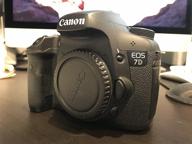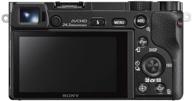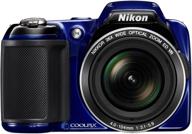- Working with fast lenses Rotary display Ergonomics - quickly get used to switching functions Focus Zoom (LiveView) Electronic horizon
- Lack of panoramic shooting
- canon
- I agree with the previous speaker "The mode rotation ring has a stopper, which makes everything difficult and does not allow you to quickly switch. I still don’t understand why a lock is needed there." I will note myself - the rotary LCD screen is somewhat incomprehensible - it is not possible to shoot from it - it does not focus on sharpness, well, for a very long time. So the whole point of turning is to protect the screen from scratches?
- Weight, build quality, good photos, comfortable grip . and much more
- To open the matrix, you need very good optics - prices :(, at high ISOs it's noisy
- Swivel display, 18 megapixels, convenient joystick, external LCD, not very bulky camera, excellent quality housing, good shooting speed in the series, convenient menu, inexpensive and high-quality (for starters) 18-135IS lens, excellent video.
- The grip is worse than on the 50D, there is NO autofocus in the video, the D7000 loses a little in terms of noise, the control is not very intuitive, nevertheless, the whale lens does not reveal the potential of the camera, an external microphone is required to record good (!) sound.
- Convenient, fast and quiet. Value for money: quality is beyond praise (took bodi for 30). After 400d, a tangible step forward. I think that for amateur photography or at a wedding, it’s better not to earn extra money.
- Haven't revealed yet. It is necessary to relearn a little how to manage, as some functions are "hidden".
- case quality, size, weight and even controls are all very convenient * rotary screen very high photo quality (after 450d) shutter sound) external flash control
- * wildly inconvenient location of the delete button (every time I suffer to reach out) stupid - unnecessary button on the shooting mode selector (all other buttons are great) video mode turns on long after the photo (you need to scroll the whole wheel)
- a rangefinder on the lens, a larger battery, a swivel screen, a metal-plastic, dust and moisture-proof body, a built-in flash, video recording, good body dimensions (it fits perfectly in the hand). high aperture, you can take pictures indoors without a flash,
- For me, they are practically non-existent. Although who cares.
- 1. Swivel screen - helps in different situations! 2. Fully manual white balance. 3. Video-worthy quality. 4. Lightweight aluminum alloy, not plastic as many people think!
- 1. Price! 23-24k carcass limit! 2. Really working iso up to 1250, and then it makes noise, but tolerable. 3. AWB-sometimes lies. 4. Capricious matrix - loves light optics!
- I will judge from the position of a beginner, and I think it will come in handy for those who want to take their first DSLR. So the advantages: As already mentioned, this is a grip. If you choose a DSLR, hold it in your hands. In general, the ergonomics of the entire apparatus. Excellent LCD display, clear menu in which it is impossible to get confused. RAW conversion directly in the camera, fast focus through the viewfinder, the presence of a built-in electronic gyroscope, bracketing, the overall quality of the device.
- The button for deleting files is inconveniently located, the presence of a lock button on the "drum" for selecting shooting modes (it is very inconvenient to press it every time to select the desired mode, although I shoot mainly on M), the built-in speaker is of mediocre quality. Lack of alignment.
- build quality, functionality, rate of fire
- he would have FF, for girls it can be heavy with good optics.
- For amateurs: The ability to take great pictures in automatic modes without wasting time on settings, the ability to process RAW photos in the camera. For the pros: the ability to select settings and ISO with low resolution, correction of XA, distortion, noise. The rotary display will also help out in reporting.
- They are determined by the capabilities and aperture ratio of lenses. Spending on L-series lenses is not very effective due to the small area of the lens. Focus requires control. Despite the excellent video, it needs to be processed at least from noise. This is not a camcorder (manual zoom and focus)
- 1) Quality and place of manufacture (Japan) 2) Ease of use. 3) Weight, size. 4) Large battery capacity. 5) Swivel screen with good resolution. 6) The presence of a second monochrome screen (with backlight) 7) The relative simplicity of the menu and camera settings. 8) Fast burst shooting (5.3 frames per second at maximum jpeg quality - 58 frames per burst, minimum - 7 frames per burst when getting max jpeg and max raw at the same time) 9) Photo quality 10) 1080p video recording with many manual settings (even while shooting)
- 1) Lack of lens hood in the kit 2) Only manual focus when shooting video (autofocus could come in handy) 3) Digital zoom (5x or 10x) in 60d, unlike 600d, cannot be used when shooting video. Here it is used only for focusing. For me, a big minus, because given the size of the matrix, the digital zoom turns out to be quite good and could come in handy in the video. It seems that this can be changed with an alternative firmware. 4) The mode rotation ring has a stopper - you cannot make more than one turn in any direction, while the choice of the video mode is located at the very stop behind the base mode zone - that is, if for example you need to shoot a video, and I shoot in Av mode, you need to go through the entire circle in reverse side to twist the ring modes, unlocking that long. 5) Blocking the ring of modes (a controversial step, for me - this is not necessary and only slows down the switching of shooting modes)
- Great camera
- Not found
- One solid merit
- The only thing that does not suit me in it is that the display exaggerates the brightness of colors a little and is heavy
- Fits well in the hand, convenient menu. Probably, the swivel display can also be attributed to the merits, but who cares, for a professional, on the contrary, this is a minus to the class, but I think for a "semi-professional" - why not. Quality. The picture is very pleasing. I really lacked quality at high ISOs, and after 450d, 800, 1000 and up to 1600 ISO, they opened a second wind. Ergonomics is certainly interesting, but still it's a matter of habit. Although, I probably agree with the reviews about the wheel on the rear panel - it is female, what can I say, it will be inconvenient for a male photographer for sure. And what I write about the inconvenient location of the photo delete button is nonsense, what is the left hand for? For me, it's completely convenient. Another pleasing option is the ability to choose the method of numbering photos when shooting.
- Autofocus. Maybe, of course, I am biased in my opinion, but still, I just can’t understand: is the 60d autofocus system inferior to 450d ?! I can't believe it, but practice proves otherwise. Focus is very slow, hesitant and takes a long time to think in medium-low light. Button to select the shooting mode. It's probably not even a disadvantage. It's just a useless thing, the mode wheel still turns when it's not necessary, and when it's necessary, and you need speed, it gets in the way.
- Personally, I like the device 100%, but I will try to talk about the pros and cons to make it easier to make a choice. And so, the pros: 1) High-quality assembly. No backlashes, no gaps. Everything is assembled clearly and very high quality 2) Aluminum chassis. Aluminum is different. If someone thinks that this is bad, then read the characteristics of the D16T aluminum alloy. 3) Ease of management. Very helpful navipad (scroll wheel with joystick function. 4) Monochrome screen. It will seem to someone that this is unnecessary pampering, but you will not believe how much it really speeds up the work. After a camera with this screen, picking up the 600D, I felt a wild inconvenience and slowdown when adjusting the shooting parameters. And even the 650D's touch screen, which is designed to speed up and increase ease of setup, still does worse than direct control on a monochrome screen. 5) Quality of photos in studio shooting. Photos at low ISO values (up to 800 units) show amazing results. With a full-length portrait, the detail of each hair on the head and even the texture of the skin is preserved. But of course when using NOT whale lenses. 6) Energy efficiency. The camera is one of the best in terms of battery consumption. A full charge is really enough for more than 1000 shots, and taking into account the use of synchronizers. With the built-in flash, a charge is enough for about 600-700 shots. 7) Pretty tenacious autofocus. If everything is in order with the adjustment, then autofocus on USM lenses is not inferior in speed to 5dm3. 8) Rotary screen. Pampering, but helped out several times when it was necessary to shoot from a lower angle (from the floor). But for this I had to turn on the LV mode, and it is wildly slow and it is not realistic to shoot a report with it. Suitable only for leisurely staged filming. 9) The built-in flash can wirelessly fire external SpeedLite series flashes. 10) Shutter speed up to 1/8000 sec. Like professional cameras.
- 1) The matrix is noisy. At sensitivity above 800, the noise is already obscene. Therefore, without fast optics or flashes, shooting at dusk is practically not an option. The only way out is to increase the exposure time, but of course you can immediately forget about reportage shooting. 2) Burst memory buffer. With a sufficiently high rate of fire, the buffer fills up instantly. When shooting in RAW, the memory is enough for a maximum of 7 frames and the speed drops sharply. Even the most expensive and fastest SD cards do not save. 3) Automatic white balance guesses in 70% of cases. It is better not to use the preset options for balance settings at all, because. they have never given the desired result. As a result, we need to either set the balance on a gray mark each time, or trust the automation, but double-check the footage.
















